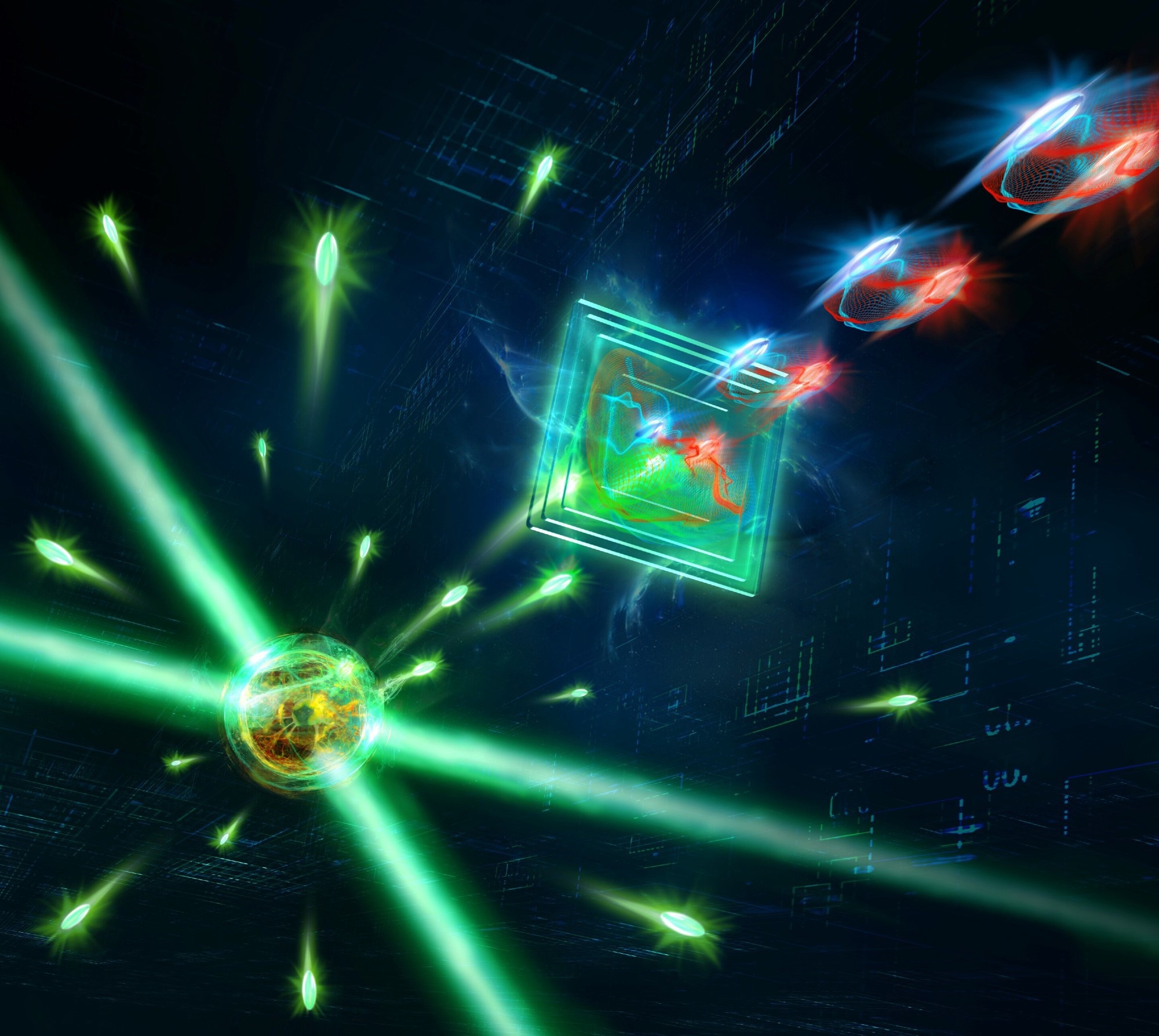Partners in the DAALI project, Jürgen Volz and Arno Rauschenbeutel of the Department of Physics at the Humboldt University of Berlin, have provided fresh insights into the light-scattering behavior of fluorescent atoms that could have applications in quantum communication. The findings were recently published by the study team in the journal Nature Photonics.
 A single atom is excited by laser light and scatters one photon after another. An optical filter removes certain color components from this stream of single photons. This causes the remaining photons to become pairs that leave the filter simultaneously. (Image: Department of Physics, Humboldt-Universität zu Berlin). Image Credit: Department of Physics, Humboldt-Universität zu Berlin
A single atom is excited by laser light and scatters one photon after another. An optical filter removes certain color components from this stream of single photons. This causes the remaining photons to become pairs that leave the filter simultaneously. (Image: Department of Physics, Humboldt-Universität zu Berlin). Image Credit: Department of Physics, Humboldt-Universität zu Berlin
Max Planck postulated in 1900 that light could only exchange certain discrete “energy packets,” or quanta, with matter, such as an atom, and not arbitrary amounts of energy. After five years, Albert Einstein postulated that these quanta were more than just a quantity used in computation and that light itself was made up of quanta, or what is now referred to as photons.
In reality, photodiodes that are sensitive enough to register a single photon are currently available. Continuous lighting produces a succession of short current pulses rather than a steady electrical signal. The detection of a single photon is thus shown by each current pulse.
Under the Magnifying Glass: Scattering of Laser Light
A single photon will never be recognized simultaneously by such a highly sensitive photodiode when it is stimulated to fluoresce by a laser beam. Since photons occur simultaneously in laser light, the fluorescent light emitted by a single atom is not the same as the laser light it is excited by in this regard.
However, if a single atom is struck by two laser photons at the same moment, it will only absorb one of the photons and let the other one pass. The atom will not be ready to accept another laser photon until it has emitted the one it had absorbed in an arbitrary direction.
In other words, a single atom can only scatter one photon at a time, and the photons in a single atom's fluorescent light impact the detector as if they were pearls on a string. This feature is being used in the DAALI project and other quantum technology studies. In quantum communication, for example, single photons generated by natural or manufactured atoms are employed for tap-proof transmission.
Through the Filter: Single Photons Become Pairs
However, researchers at Humboldt University have now demonstrated a remarkable effect utilizing fluorescent light from a single atom. When the researchers used a filter to remove a certain color component from the light, the single photon stream converted into pairs of photons that were detected simultaneously.
Therefore, from a stream of single photons, the proper ones are removed, and the remaining photons appear as pairs. The impression of the real world and this effect are incompatible; for example, if all green automobiles are removed from a street, the remaining cars will not start to drive in pairs beside one another.
Furthermore, the earlier assurance that a single atom could only scatter one photon at a time has been refuted: the atom can very well scatter two photons simultaneously when viewed through the appropriate color filter.
In their theoretical work on the scattering of light by atoms at ENS Paris, Jean Dalibard and Serge Reynaud anticipated this effect around forty years ago. But it has only just been proven empirically by the group headed by quantum physicists Rauschenbeutel and Volz.
This is a wonderful example of the extent to which our intuition fails us when we try to get an idea of how processes occur at the microscopic level.
Jürgen Volz, Assistant Professor, Department of Physics, Humboldt University of Berlin
Rauschenbeutel added, “However, this is much more than just a curiosity. Indeed, the photon pairs generated are quantum-mechanically entangled. So, there is the spooky action at a distance between the two photons that Einstein didn't want to believe in and thanks to which one can teleport quantum states, for example.”
Volz and Rauschenbeutel stated, “That a single atom is ideally suited as a source for such entangled photon pairs is something hardly anyone would have believed until recently.”
The effect that has been shown genuinely renders it possible to realize sources of entangled photon pairs that are brighter than current sources, reaching the theoretical maximum. Moreover, the pairs of photons are intrinsically matched to the atoms from which they originated. This enables direct photon-quantum contact with quantum gates or repeaters, which share the same atoms and are necessary for long-range quantum communication.
Journal Reference:
Masters, L., et al. (2023) On the simultaneous scattering of two photons by a single two-level atom. Nature Photonics. doi:10.1038/s41566-023-01260-7